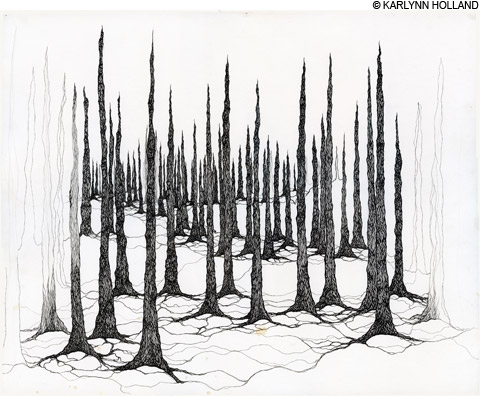
Karlynn Holland, Black Forest
In the Phoenix's first annual METAL ISSUE, we introduced you to "WE STILL SEE THE BLACK," a survey of heavy metal-themed art that opens with a reception tonight at the New Art Center in Newton. (Here's a slideshow of works that'll be included.) For a quick introduction to a few of the artists, read the preview piece that we ran then. Here's a longer version of the interview we did with KARLYNN HOLLAND, whose work has been used by bands including Krallice and Nachtmystium -- and if one of those bands makes your head explode, she can also help piece your skull back together.
What are you showing in “We Still See The Black?”
It’s
three drawings that I’ve completed in the past four or five years. I
often work on as many as ten pieces at a time and rotate between them.
So of the three forest drawings that are [coming] up there, two are a
little larger -- 19x24 -- and one that’s smaller. The smaller piece was
featured by a band Krallice out of Brooklyn, New York. But it wasn’t
made for them. I was doing portraiture at the time, and I needed a way
to warm up my hand and get the ink flowing through the pens and that’s
kind of where they came out of. They were the practice before I would
work on someone’s face. I would sit there and trace over the lines over
and over and over again and these scenes would build up. But if you look
at them, if I were to make a mistake, or a stray line, it easily fits
back into the style. So they were preparation in a lot of ways, but then
they had a life of their own that I found very compelling. And I kept
working on them until I felt they were at a place where they stand on
their own. I wouldn’t say that they’re necessarily finished -- the lines
don’t go all the way to the edges -- but they have what they need.
When you say you were warming up for portraits: were those your demon portraits?
Yes.
Before
we talk about those: there’s photos on your website of some forensic
reproduction work that you’ve done. This isn’t illustration, it’s three
dimensional and anatomical and sculptural. Do you do that
professionally?
No,
it’s much more of a hobby. Most jobs in forensic reconstruction are in
in law enforcement, and I have no interest in being a police officer, at
least right now. So it’s something that I have and I always offer it,
whenever I can contribute to someone I know who’s working on an
archaeological project or whatever -- I just have a passion for it but
it’s not something I do professionally.
You had something to do with the head on the Nachtmystium record?
I did! I sculpted a head! And cast it and molded it and they used it as a model on the cover. [Ed note: Her sculpture formed a base that was reworked by illustrators; the final image was a collaboration of several people]

Some
of your demon portraits have these axes, or these points that look like
blueprints for a more three-dimensional design. Is that informed in any
way by your reconstruction work?
Absolutely.
[The demon portraits are] always a collaboration. I’m the hand but the
person I’m drawing, I always let them pick what they become. So yeah I
think about it in that way. When I think about the way the horns -- or,
if something actually grew out of the skull, how would it fit in space?
That’s definitely something I take into high consideration.
You’ve
done work for metal bands, but your art, especially the line drawings,
seems so much more spare and austere than what we think of as
traditional metal artwork. And yet it’s been embraced by bands. To what
extent has metal been an influence on you?
Metal
has been a huge influence on my life, and it was a changing point in my
late teens, or early 20s. I think a lot of metalheads got into it
pretty early, but I was like 18 or 19 when I really fell into it. I grew
up in a really small town. The metalheads who were there, I was like,
“You guys are idiots,” a little bit? Rednecks and like holding up gas
stations? And I didn’t want anything to do with that. I just wanted to
have a good time and go see music. So it wasn’t until after I went to
college that I found that whole world and how deep its roots went.
I
was completely fed up with radio at the time and was listening to a lot
of classical and world music, actually -- Bach or traditional folk
music from Kurdistan and Uzbekistan. And they all share this thing in
common, which is that they’re very improvisational, and these dudes are shredders
on their instruments. And out of that I found some people who were
like, “Well, take a chance on this, [even though it] doesn’t seem like
it would be your vibe.” And I dove in head first. I think it gave me
permission to explore some of the darker shadows that I’d always had an
interest in.
You’ve
done a few logos at this point. And logos, in metal, are such a huge
part of a band’s identity. And we all remember what it was like to see a
Metallica or Megadeth or an Iron Maiden logo. That’s obviously gotten
so much more intense over the years, with death metal logos and black
metal styles of doing those things. Can you walk through how you’ve done
these logos, and how you get from a blank page to something that the
band is willing to put their name behind?
Yeah,
I love that you mentioned the genres. You can look at the logos and
know what the band sounds like without ever hearing them. You know if
it’s a black metal band or a death metal band or grindcore or punk, just
from the way the logo looks. So when I start with a band I ask them,
who are your influences? Who do you listen to? What is it you’re going
for? And then I also ask them, like, What are your favorite TV shows?
You know, give me all the information. And from that I just try to
distill a portrait of the band. I really think of the logos the same way
I think of portraits. They’re specific, and individual, and they have
identifying characteristics. If you train your eye, you don’t just see
that this is a grindcore band, you know a little bit more than that.
Like it’s a grindcore band, and also they probably listened to a ton of
hardcore when they were kids. Let it bleed thorugh, let it come out:
that’s how I approach it.
That
Krallice logo you did feels like it’s got a bit of you in it. It’s got a
bit of that real spare kind of style. Was that a bit of a departure for
them?
No,
you know, we messed around with a couple versions of it where I gave it
more fuzz or let it drip or tried to expand it in some way. But it was
sort of unanimously agreed that the bonework, if you will, the basic
structure of it, just stood on its own in this way. That was the band’s
call, I would have been willing to do either. But I do like the
spareness and I like that you do see my hand in it, it’s not wearing a
disguise.
What are you working on now?
More
portraits. I’ve got five or six of them in my room, sadly. Tons of
logos. I don’t want to say any names before anything comes out. I’ve
gone back to doing some painting on vinyl, which is something I did in
college.
There’s
one project I can let go -- Kevin Hufnagel from Dysrythmia and Gorguts
is doing a solo ukulele EP. Ohmigod, it blows my mind. Haunting.
Amazing. So I’m doing a monogram for him, and in the [black forest]
style I did a mountain drawing.
 On The Download
On The Download  We Still See the Black: Artist Karlynn Holland on black forests, metal logos, and drawing your inner demon
We Still See the Black: Artist Karlynn Holland on black forests, metal logos, and drawing your inner demon On The Download
On The Download  We Still See the Black: Artist Karlynn Holland on black forests, metal logos, and drawing your inner demon
We Still See the Black: Artist Karlynn Holland on black forests, metal logos, and drawing your inner demon

















